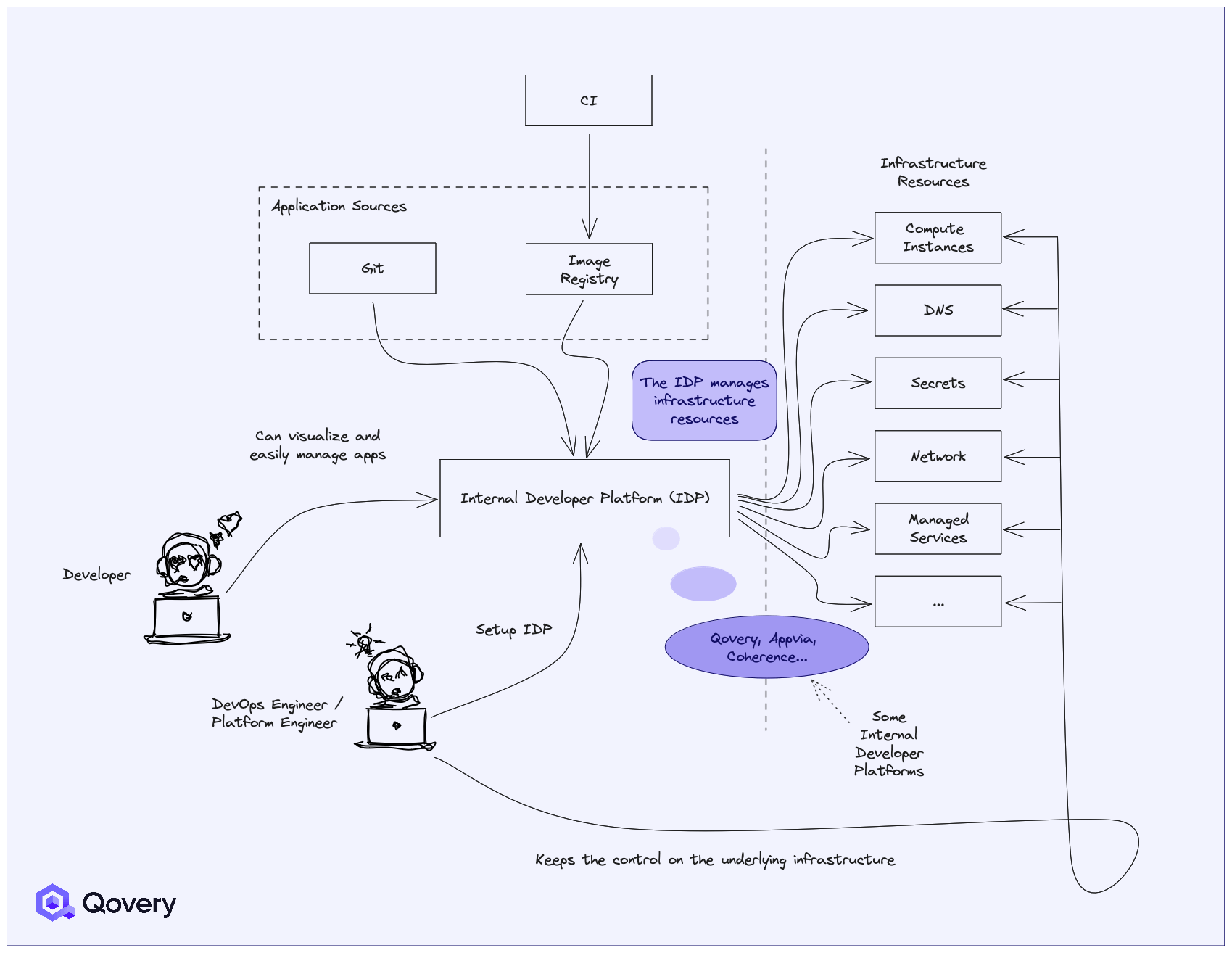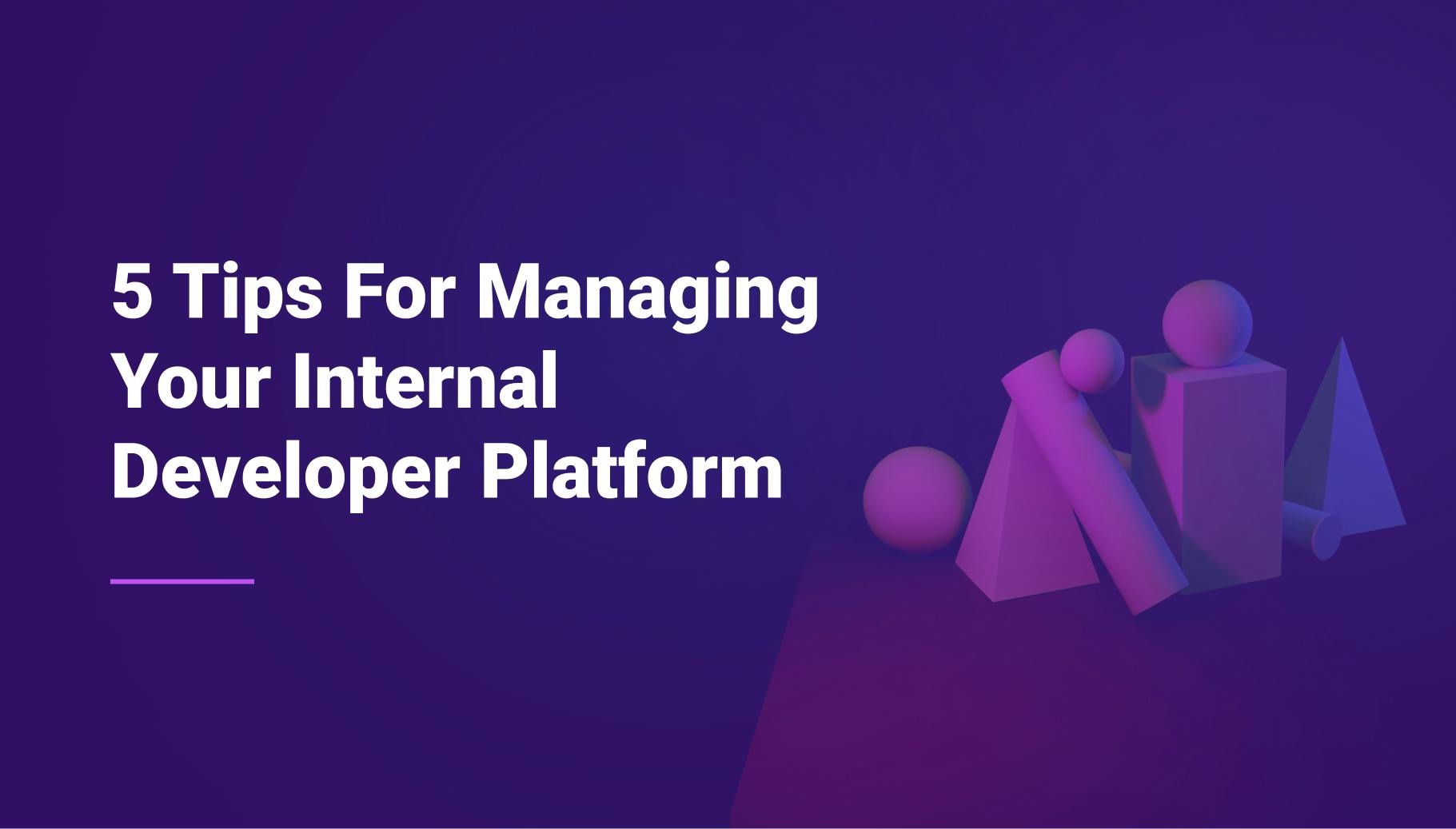Introduction to Internal Developer Platforms: What, Why, and How?
For top-notch organizations, staying ahead of the curve is not just a choice; it's a necessity. To meet the growing demands of modern development, organizations are increasingly turning to Internal Developer Platforms (IDPs) as a solution to fine-tune their workflows. This article aims to demystify IDPs, shed light on their benefits, and guide you on how to embark on your IDP journey.

Morgan Perry
October 12, 2023 · 6 min read
#What is an Internal Developer Platform?
An Internal Developer Platform (IDP) is a comprehensive software solution that acts as an integrated and automated framework for managing the end-to-end software development lifecycle within an organization. It provides a unified environment where development teams can access a suite of tools, resources, and services essential for coding, testing, deploying, and maintaining software applications. An IDP typically includes functionalities such as version control, continuous integration/continuous deployment (CI/CD) pipelines, container orchestration, infrastructure provisioning, automated testing, and monitoring.
From a technical standpoint, an IDP serves as the central nervous system of an organization's software development ecosystem. It standardizes workflows, promotes collaboration, enforces best practices, and enhances security, all while minimizing manual interventions and streamlining development processes. It abstracts infrastructure complexities, allowing developers to focus solely on writing code and delivering high-quality software efficiently.
Put simply, an IDP empowers engineering teams to optimize their software delivery pipelines, reduce development cycle times, and ensure the consistency, reliability, and security of software applications throughout their lifecycle.
Note that the Internal Developer Platform differs from the Internal Developer Portal. I invite you to read this article: Internal Developer Platform vs. Internal Developer Portal: What's The Difference?

#Key Pillars and Characteristics of an Internal Developer Platform
- Unified Tooling: IDPs bring together a suite of development tools, from code repositories to CI/CD pipelines, into a cohesive interface. This unified tooling simplifies the development process and reduces the need to switch between disparate tools.
- Automated Workflows: IDPs automate repetitive tasks such as environment provisioning, deployment, and scaling. This automation accelerates development cycles and minimizes manual errors.
- Self-Service Capabilities: Developers can self-serve resources and environments, reducing reliance on IT or DevOps teams. This empowers developers to work independently and speeds up development iterations.
- Scalability: IDPs are designed to scale seamlessly with the organization's growth. Whether you have a small development team or a large enterprise, the platform can accommodate your needs.
- Security: Robust security features are integral to IDPs. They include access controls, encryption, and audit trails to protect sensitive data and ensure compliance.
#Main Benefits of an IDP for Engineering Teams
Implementing an IDP not only transforms the development landscape but also brings a multitude of benefits to engineering teams:
#Increased Development Speed
One of the primary advantages of an IDP is the significant boost in development speed. By streamlining workflows and automating manual tasks, developers can focus on writing code and delivering features faster. This acceleration in development pace can be a game-changer in today's competitive markets.
#Enhanced Collaboration
IDPs break down silos between development, operations, and other cross-functional teams. With a centralized platform, collaboration becomes seamless. Developers, quality assurance engineers, product managers, and other stakeholders can work closely together, leading to quicker issue resolution, improved feature delivery, and overall better software quality.
#Improved Productivity
Developers thrive in an environment that minimizes distractions and roadblocks. IDPs provide just that by eliminating many of the barriers that slow down development. Developers can work in a standardized and efficient environment, reducing the cognitive load associated with managing different tools and systems. This, in turn, boosts their productivity and creativity.
#Consistency and Quality
Maintaining consistent code quality and deployment procedures across development teams can be challenging. IDPs enforce best practices and standardization throughout the development process. This ensures that code quality, security measures, and deployment procedures adhere to organizational standards. The result is more reliable and stable software releases.
#Scalability and Adaptability
Whether your organization is a startup experiencing rapid growth or a large enterprise with complex development needs, an IDP can scale to meet your requirements. As your team and projects expand, the platform can adapt and accommodate the increased workload. This scalability ensures that the IDP remains an asset as your organization evolves.
#Challenges and Best Practices
While IDPs offer numerous advantages, they also come with their fair share of challenges. Here are some common obstacles you may encounter and best practices to address them:
#Challenge 1: Resistance to Change
Best Practice: Involve your development teams in the decision-making process. Address their concerns and provide training to ensure a smooth transition. Clearly communicate the benefits of the IDP to gain buy-in from all stakeholders.
#Challenge 2: Integration Complexity
Best Practice: Prioritize IDP solutions that offer seamless integration with your existing tools and technologies. This minimizes disruption to your current workflows and reduces the learning curve for your teams.
#Challenge 3: Security Concerns
Best Practice: Implement robust security measures within the IDP, such as access controls, encryption, and regular security audits. Educate your teams on security best practices and the importance of safeguarding sensitive data.
#Challenge 4: Overcustomization
Best Practice: While customization is essential, avoid overcustomization that may lead to complexity and maintenance challenges. Strike a balance between flexibility and standardization. Regularly review and optimize your customization to ensure it aligns with evolving development needs.
#Getting Started with an Internal Developer Platform
Implementing an IDP is a strategic move that requires careful planning and execution. Here's a step-by-step guide to help you get started:
- Assess Your Needs: Begin by evaluating your organization's specific development requirements. Consider factors like the size of your team, the complexity of your applications, and your existing tech stack. This assessment will guide your choice of IDP solution.
- Select the Right IDP: There are various IDP solutions available like Qovery, each with its own set of features and capabilities. Choose one that aligns with your organization's goals and technical requirements. Key factors to consider include scalability, integration capabilities, and ease of use.
Discover the 10 Best Internal Developer Platforms to Consider in 2023 - Initial Setup: Once you've selected an IDP, it's time to set up the platform. This involves configuring user roles, and permissions, and integrating them with your existing development tools and infrastructure. Ensure that the IDP integrates seamlessly with your existing tech stack.
- Onboarding: Train your development teams on how to use the IDP effectively. Ensure they understand how to leverage the platform's features to streamline their workflows. A well-structured onboarding process is crucial for the successful adoption of the IDP.
- Customization: Customize the IDP to suit your organization's specific needs. Tailor it to match your development processes and best practices. This step is crucial for maximizing the benefits of the platform and ensuring that it aligns with your unique requirements.
- Deployment: Roll out the IDP gradually, starting with a pilot project or a small team. Monitor its performance and gather feedback from users to make necessary improvements. This phased approach minimizes disruptions and allows you to fine-tune the platform.
- Scaling Up: As your organization gains confidence in the IDP, expand its usage across your development teams. Continuously assess its impact and make adjustments as needed. Scalability is a key factor in ensuring that the IDP can accommodate your growing development needs.
#Conclusion and Next Steps
Internal Developer Platforms have emerged as a game-changer in a world where software development is a competitive advantage. They offer organizations the opportunity to streamline workflows, enhance collaboration, and boost developer productivity.
As you consider adopting an IDP, remember that it's not just a technology choice; it's a strategic move to optimize your development processes. Start by assessing your needs, selecting the right platform, and customizing it to fit your organization. Embrace the challenges as opportunities for growth, and always keep an eye on best practices.
By leveraging the power of Internal Developer Platforms with tools like Qovery, you can propel your organization toward a future where software development is not just efficient but also a driving force for innovation and success. Get started on your IDP journey today and see your development teams thrive.
Your Favorite Internal Developer Platform
Qovery is an Internal Developer Platform Helping 50.000+ Developers and Platform Engineers To Ship Faster.
Try it out now!

Your Favorite Internal Developer Platform
Qovery is an Internal Developer Platform Helping 50.000+ Developers and Platform Engineers To Ship Faster.
Try it out now!

